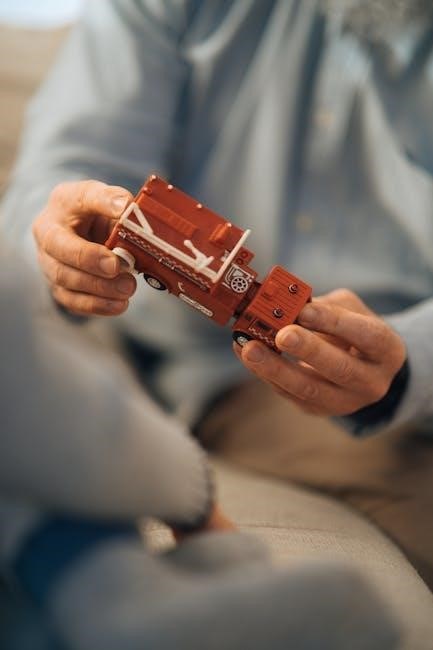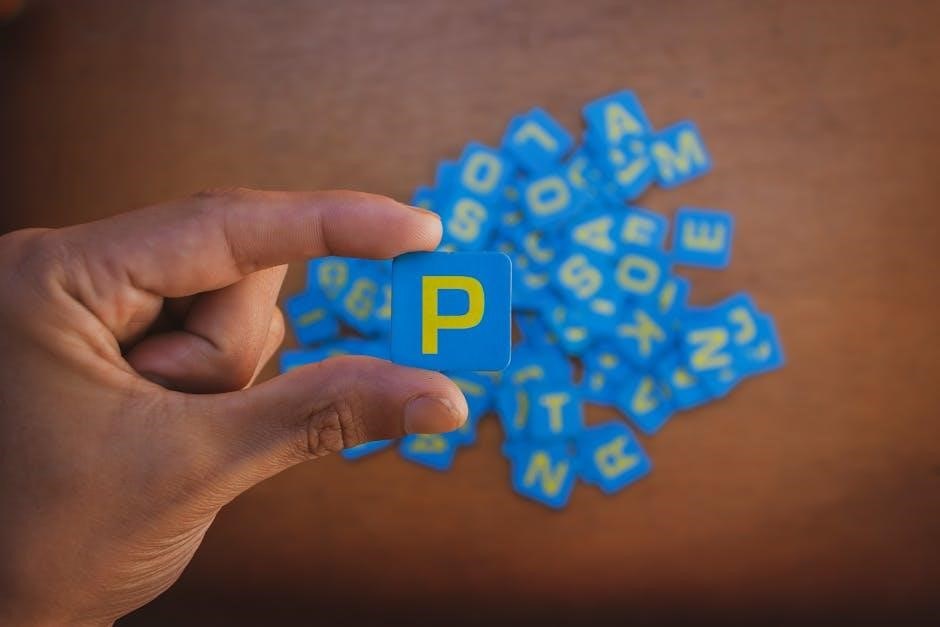FTC CENTERSTAGE Game Manual 2: A Comprehensive Guide
Welcome to the essential guide for mastering the FTC CENTERSTAGE game! This manual offers a deep dive into advanced gameplay, building upon foundational knowledge. Discover detailed explanations of rules, scoring nuances, and strategic play. Prepare to elevate your team’s performance with insights designed for competitive success in CENTERSTAGE.
The FIRST Tech Challenge (FTC) CENTERSTAGE, presented by RTX, marks an exciting chapter in competitive robotics. This season challenges teams to design, build, and program robots capable of navigating a complex arena and executing intricate tasks. CENTERSTAGE demands a blend of innovative engineering, strategic gameplay, and collaborative teamwork. As teams embark on this journey, a thorough understanding of the game manual, particularly Game Manual 2, becomes paramount.
Game Manual 2 delves deeper into the specifics of CENTERSTAGE, offering clarifications, updates, and detailed explanations of rules. It serves as an indispensable resource, guiding teams through the nuances of the game and providing insights into effective strategies. This introduction sets the stage for exploring the key elements of CENTERSTAGE, from game objectives and scoring systems to robot design considerations and programming strategies.
Whether you are a rookie team or a seasoned competitor, embracing the challenges of CENTERSTAGE requires a commitment to learning, adapting, and pushing the boundaries of robotics innovation. Get ready to explore the dynamic world of FTC CENTERSTAGE and unleash your team’s full potential!
Understanding Game Objectives

In the FTC CENTERSTAGE game, teams are tasked with achieving a variety of objectives to score points and ultimately win matches; A clear understanding of these objectives is crucial for developing effective strategies and designing robots that can perform the necessary tasks. The primary objectives revolve around navigating the playing field, manipulating game elements, and interacting with alliance partners.
Teams must work together in alliances to maximize their score, requiring careful coordination and communication. Autonomous programming plays a significant role, with teams aiming to score points independently at the beginning of the match. Tele-operated control allows for direct robot manipulation by drivers, enabling precise actions and strategic decision-making. End game tasks offer additional scoring opportunities, incentivizing teams to develop creative solutions for the final moments of the match.
Mastering these game objectives requires a deep understanding of the rules and regulations outlined in Game Manual 2. By focusing on key tasks and developing innovative robot designs, teams can position themselves for success in the CENTERSTAGE competition. Strategic planning and efficient execution are essential for achieving victory.
Scoring System Breakdown
A thorough understanding of the scoring system in FTC CENTERSTAGE is vital for developing winning strategies. Points are awarded for various tasks completed during both the Autonomous and Teleop periods, as well as during the End Game. Each action, from navigating the field to manipulating game elements, contributes to the overall score.
In Autonomous, teams can earn points by completing pre-programmed tasks without driver intervention. This includes tasks like moving the robot, delivering elements, and strategically positioning for the Teleop period. During Teleop, drivers control the robots to score points by placing game pieces, interacting with field elements, and hindering the opposing alliance.
The End Game offers bonus opportunities for high-value actions. Successfully completing these tasks can significantly boost a team’s score. Penalties are assessed for rule violations, so teams must be meticulous in adhering to the game rules. Analyzing the point values associated with each task allows teams to prioritize their actions and maximize their scoring potential, leading to success in the CENTERSTAGE competition.
Key Game Rules and Regulations
Adhering to the key game rules and regulations of FTC CENTERSTAGE is paramount for fair play and competition integrity. These rules govern every aspect of the game, from robot specifications to gameplay conduct, ensuring a level playing field for all participating teams. A comprehensive understanding of these regulations is crucial for avoiding penalties and maximizing performance.
Robot design must adhere to strict size and weight limitations, as outlined in the game manual. Teams must also comply with rules regarding permitted materials and components. During gameplay, specific rules govern robot interactions, zone restrictions, and element manipulation. Violations can result in point deductions or disqualification, impacting the overall match outcome.
The game manual provides detailed explanations of all rules, including clarifications and updates issued throughout the season. Teams should meticulously review these regulations to ensure compliance. Understanding the nuances of the rules allows teams to develop strategies that push the boundaries of the game without incurring penalties. Maintaining a strong understanding of the rules is the cornerstone for ethical and successful participation in FTC CENTERSTAGE.
Robot Design Considerations for CENTERSTAGE

Designing a competitive robot for FTC CENTERSTAGE requires careful consideration of various factors, balancing functionality, efficiency, and strategic advantage. The robot’s design should align with the game’s objectives, enabling it to perform key tasks effectively. Maneuverability is crucial for navigating the playing field and executing strategic plays.
Teams must consider the robot’s ability to collect, transport, and score game elements. The design should optimize these processes for speed and accuracy. Robust construction is essential to withstand the rigors of competition, ensuring reliability throughout multiple matches. Weight distribution and stability are critical for maintaining balance and preventing tipping.
Furthermore, the robot’s design should accommodate potential upgrades and modifications. Modular designs allow for easy adaptation to evolving game strategies and rule changes. Integrating sensors and feedback mechanisms enhances autonomous capabilities and improves overall performance. Teams should also prioritize ease of maintenance and repair, minimizing downtime during competitions. Thoughtful design choices are critical for building a winning robot in FTC CENTERSTAGE.
Programming Strategies for Autonomous Mode
Autonomous mode in FTC CENTERSTAGE presents a significant opportunity to gain a competitive edge through pre-programmed actions. Effective programming strategies are crucial for maximizing points during this phase. Accurate sensor integration, including encoders, gyroscopes, and color sensors, is essential for precise navigation and object detection.
Path planning algorithms enable robots to efficiently traverse the field, avoiding obstacles and reaching target locations. Teams should develop robust error handling routines to account for unexpected events or variations in field conditions. Utilizing state machines can streamline complex autonomous sequences, ensuring reliable execution of multiple tasks.
Calibration procedures are vital for maintaining accuracy over time, compensating for sensor drift or mechanical wear. Furthermore, teams should prioritize code optimization to minimize execution time and maximize the number of actions performed. Testing and iteration are critical for refining autonomous routines and identifying potential issues. A well-designed autonomous program can significantly impact a team’s overall success in FTC CENTERSTAGE.
Alliance Strategies and Gameplay Dynamics
Success in FTC CENTERSTAGE hinges significantly on effective alliance strategies and a deep understanding of gameplay dynamics. Teams must collaborate seamlessly with their alliance partners to maximize scoring opportunities and defend against opponents. Communication is paramount; clear and concise messaging ensures coordinated actions and minimizes conflicts on the field.
Developing pre-match strategies that leverage each robot’s strengths is crucial. This includes assigning roles, such as scoring, defense, or support, based on robot capabilities and programming. Adapting strategies on the fly is equally important, as match conditions can change rapidly. Observing opponent behavior and identifying weaknesses allows alliances to exploit vulnerabilities and gain an advantage.
Understanding the scoring potential of various game elements is key to prioritizing actions. Alliances should focus on high-value tasks while also denying scoring opportunities to the opposing alliance. Effective teamwork, strategic decision-making, and adaptability are essential for navigating the complexities of alliance gameplay and achieving victory in FTC CENTERSTAGE.
Game Manual Part 2 Updates and Clarifications
Staying current with the latest updates and clarifications to the FTC CENTERSTAGE Game Manual Part 2 is critical for competitive teams. This section highlights key revisions and interpretations that impact gameplay, robot design, and scoring. Teams must carefully review these updates to ensure compliance and avoid penalties during competition.
Clarifications often address ambiguous rules or provide specific examples to guide teams in interpreting the manual. Updates may introduce new rules, modify existing ones, or adjust scoring values based on game observations and feedback from the FIRST community. These changes are typically released to promote fair play and enhance the overall competition experience.
Regularly checking the official FIRST website and Q&A forums is essential for staying informed about the most recent manual updates and clarifications. Teams should also discuss these changes within their teams and adjust their strategies and designs accordingly to maintain a competitive edge throughout the season.
Official Q&A and Rule Interpretations
Navigating the complexities of the FTC CENTERSTAGE game requires a thorough understanding of the rules and their intended interpretations. The official Q&A forum serves as a vital resource where teams can seek clarification on specific rules and game scenarios. These official interpretations provide authoritative guidance, ensuring consistent application of the rules across all competitions.
Before posting a question, teams should first consult the game manual and existing Q&A entries to see if their question has already been answered. When submitting a new question, it’s essential to be clear and concise, providing specific details about the rule or situation in question. The Game Design Committee reviews and answers questions, and their responses are considered official rule interpretations.
Understanding these interpretations is crucial for developing effective strategies and designing compliant robots. Teams should regularly monitor the Q&A forum for new postings and updates, as these can significantly impact their approach to the game.
Resources for Rookie Teams

Embarking on your FIRST Tech Challenge journey as a rookie team can be both exciting and overwhelming. Fortunately, a wealth of resources is available to help you navigate the challenges and build a successful robotics program. Start with the FIRST website, which offers comprehensive guides, tutorials, and documentation.
The game manual is your most important resource, providing detailed rules, scoring information, and gameplay guidelines. Supplement this with online tutorials covering robot design, programming, and team management. Don’t hesitate to reach out to experienced teams or mentors for guidance and support. Many teams are eager to share their knowledge and help newcomers succeed.
Consider attending workshops or training sessions offered by local FIRST organizations or robotics clubs. These events provide hands-on learning opportunities and networking possibilities. Remember, learning is a continuous process, so embrace the challenges, ask questions, and celebrate your achievements along the way. Utilize the curated list of pertinent pages designed to help rookie teams.
Effective Team Strategies for Success
Success in the FIRST Tech Challenge hinges on developing and executing effective team strategies. Begin by thoroughly understanding the game objectives, scoring system, and rules outlined in the CENTERSTAGE Game Manual. Analyze the game to identify key areas for scoring and potential robot designs that excel in those areas. Collaborative brainstorming sessions are crucial for generating innovative ideas and strategies.

Effective communication is essential for coordinating tasks and ensuring everyone is on the same page. Divide responsibilities based on team members’ strengths and interests, fostering a sense of ownership and accountability. Practice time management and prioritize tasks to maximize productivity during build sessions. Regularly evaluate your progress and adjust your strategies as needed based on performance and observations.
Scouting other teams and analyzing their robots can provide valuable insights into potential alliance partners and competitive threats. Develop strategies for both autonomous and driver-controlled periods, considering factors like speed, accuracy, and reliability. Remember that teamwork, adaptability, and a positive attitude are critical ingredients for achieving success in the FIRST Tech Challenge.



